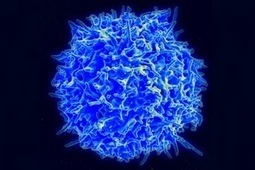Two children with an aggressive form of childhood leukemia had a complete remission of their disease—showing no evidence of cancer cells in their bodies—after treatment with a novel cell therapy that reprogrammed their immune cells to rapidly multiply and destroy leukemia cells. A research team from The Children’s Hospital of Philadelphia and the University of Pennsylvania published the case report of two pediatric patients Online First today in The New England Journal of Medicine. It will appear in the April 18 print issue.
The current study builds on Grupp’s ongoing collaboration with Penn Medicine scientists who originally developed the modified T cells as a treatment for B-cell leukemias. The Penn team reported on early successful results of a trial using this cell therapy in three adult chronic lymphocytic leukemia (CLL) patients in August of 2011. Two of those patients remain in remission more than 2½ years following their treatment, and as the Penn researchers reported in December 2012 at the annual meeting of the American Society of Hematology, seven out of ten adult patients treated at that point responded to the therapy. The team is led by the current study’s senior author, Carl H. June, M.D., the Richard W. Vague Professor in Immunotherapy in the department of Pathology and Laboratory Medicine and the Perelman School of Medicine at the University of Pennsylvania and director of Translational Research in Penn’s Abramson Cancer Center.
“We’re hopeful that our efforts to treat patients with these personalized cellular therapies will reduce or even replace the need for bone marrow transplants, which carry a high mortality risk and require long hospitalizations,” June said. “In the long run, if the treatment is effective in these late-stage patients, we would like to explore using it up front, and perhaps arrive at a point where leukemia can be treated without chemotherapy.”
The research team colleagues adapted the original CLL treatment to combat another B-cell leukemia: ALL, which is the most common childhood cancer. After decades of research, oncologists can currently cure 85 percent of children with ALL. Both children in the current study had a high-risk type of ALL that stubbornly resists conventional treatments.
The new study used a relatively new approach in cancer treatment: immunotherapy, which manipulates the immune system to increase its cancer-fighting capabilities. Here the researchers engineered T cells to selectively kill another type of immune cell called B cells, which had become cancerous.
The researchers removed some of each patient’s own T cells and modified them in the laboratory to create a type of CAR (chimeric antigen receptor) cell called a CTL019 cell. These cells are designed to attack a protein called CD19 that occurs only on the surface of certain B cells.
By creating an antibody that recognizes CD19 and then connecting that antibody to T cells, the researchers created in CTL019 cells a sort of guided missile that locks in on and kills B cells, thereby attacking B-cell leukemia. After being returned to the patient’s body, the CTL019 cells multiply a thousand times over and circulate throughout the body. Importantly, they persist for months afterward, guarding against a recurrence of this specific type of leukemia.
While the CTL019 cells eliminate leukemia, they also can generate an overactive immune response, called a cytokine release syndrome, involving dangerously high fever, low blood pressure, and other side effects. This complication was especially severe in Emily, and her hospital team needed to provide her with treatments that rapidly relieved the treatment-related symptoms by blunting the immune overresponse, while still preserving the modified T cells’ anti-leukemia activity.
“The comprehensive testing plan that we have put in place to study patients’ blood and bone marrow while they’re undergoing this therapy is allowing us to be able to follow how the T cells are behaving in patients in real time, and guides us to be able to design more detailed and specific experiments to answer critical questions that come up from our studies,” Kalos said.
The CTL019 therapy eliminates all B cells that carry the CD19 cell receptor: healthy cells as well as those with leukemia. Patients can live without B cells, although they require regular replacement infusions of immunoglobulin, which can be given at home, to perform the immune function normally provided by B cells.
The research team continues to refine their approach using this new technology and explore reasons why some patients may not respond to the therapy or may experience a recurrence of their disease. Grupp said the appearance of the CD19-negative leukemia cells in the second child may have resulted from her prior treatments. Unlike Emily, the second patient had received an umbilical cord cell transplant from a matched donor, so her engineered T cells were derived from her donor (transplanted) cells, with no additional side effects. Oncologists had previously treated her with blinatumomab, a monoclonal antibody, in hopes of fighting the cancer. The prior treatments may have selectively favored a population of CD19-negative T cells.
“The emergence of tumor cells that no longer contain the target protein suggests that in particular patients with high-risk ALL, we may need to broaden the treatment to include additional T cells that may go after additional targets,” added Grupp. “However, the initial results with this immune-based approach are encouraging, and may later even be developed into treatments for other types of cancer.”
Via Dr. Stefan Gruenwald



 Your new post is loading...
Your new post is loading...









YES we CAN!!!